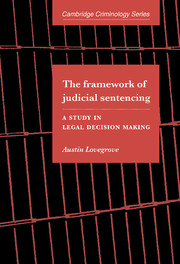Book contents
- Frontmatter
- Contents
- List of figures
- List of tables
- Acknowledgments
- 1 Judicial decision making and sentencing policy: continuation of a study
- 2 A sentencing decision model: single and multiple similar counts
- 3 A sentencing decision model: multiple disparate counts
- 4 Testing the decision model for multiple disparate counts
- 5 The techniques of data collection
- 6 Judges' thoughts on sentencing the multiple offender
- 7 An alternative sentencing decision model for the multiple offender
- 8 Validity and development of the alternative decision model: the data collection
- 9 Towards a requisite decision model for sentencing the multiple offender
- 10 The armature of judicial sentencing
- Appendix 1 Case 37 from Sentencing Research Exercise – Part 3B
- References
- Index
2 - A sentencing decision model: single and multiple similar counts
Published online by Cambridge University Press: 22 August 2009
- Frontmatter
- Contents
- List of figures
- List of tables
- Acknowledgments
- 1 Judicial decision making and sentencing policy: continuation of a study
- 2 A sentencing decision model: single and multiple similar counts
- 3 A sentencing decision model: multiple disparate counts
- 4 Testing the decision model for multiple disparate counts
- 5 The techniques of data collection
- 6 Judges' thoughts on sentencing the multiple offender
- 7 An alternative sentencing decision model for the multiple offender
- 8 Validity and development of the alternative decision model: the data collection
- 9 Towards a requisite decision model for sentencing the multiple offender
- 10 The armature of judicial sentencing
- Appendix 1 Case 37 from Sentencing Research Exercise – Part 3B
- References
- Index
Summary
Lovegrove (1989) developed a decision model describing how judges determine what is appropriate by way of sentence for a case comprising a single count, or multiple counts belonging to the same legal offence category (e.g., multiple burglaries) and properly regarded as separate transactions. The purpose of the model was to provide the basis for a numerical formula for calculating the overall seriousness of a case described in terms of several common offence factors and, then, relating this result to the appropriate quantum of sentence. The product of this work was a numerical guideline. In the achieving of this aim, it was necessary to develop a conceptual scheme representing a solution to what Ashworth (1983) identified as the problem of integrating the seriousness of two or more offences of one kind into a coherent system of proportionality principally related to the seriousness of single offences or classes of offence. So that the model was faithful to the structure of judicial thought it was based on an analysis of sentencing policy – policy dealing with the determination of sentence for particular legal categories of offence. This aspect of sentencing policy, also, is characterized by generality and incompleteness; yet a quantitative analysis demanded precision. Accordingly, it was necessary to develop the model further, and this was achieved by formulating sentencing exercises for the purpose of facilitating judicial input on matters of detail.
- Type
- Chapter
- Information
- The Framework of Judicial SentencingA Study in Legal Decision Making, pp. 36 - 51Publisher: Cambridge University PressPrint publication year: 1997



